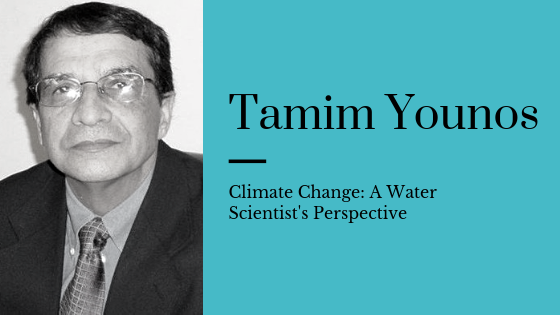Younos is Founder and President, Green Water-Infrastructure Academy, Washington, D.C. and Former Research Professor of Water Resources at Virginia Tech. He lives in Blacksburg.
Climate change refers to changes in the Earth’s climatic factors such as average temperature and global precipitation patterns measured over long periods of time, i.e., decades. Climate change science encompasses climate change causes and effects, future projections of climate change and its potential consequences. Climate change investigative tools include atmospheric science, oceanography, ecology, and fundamental sciences of biology, physics, chemistry, and geology.
Climate change science is not new. In 1896, Swedish scientist Svante Arrhenius calculated the warming power of excess carbon dioxide. He predicted that a warming trend would result if human activities increased carbon dioxide in the atmosphere. Averaged over all land and ocean surfaces, temperatures warmed roughly 1.53°F (0.85ºC) from 1880 to 2012, according to the Intergovernmental Panel on Climate Change Report (IPCC) (2013). Increase in the Earth’s surface temperature is attributed to atmospheric increase in carbon dioxide, methane, nitrous oxide, aerosols and water vapor, i.e., the greenhouse effect.
Possible causes of climate change include both natural and anthropogenic (human) impacts. In terms of human impacts, at present, there is significant focus on energy (fossil fuel) production and consumption as the major cause of climate change and regulatory requirements to control gas emissions. However, deforestation is another significant cause of climate change. Forests store carbon, sequestering it from the atmosphere. Worldwide deforestation, caused by timber industry and accelerated urbanization, contributes to increasing carbon dioxide levels (from loss of sequestration ability and burning of logged trees) and consequently the global warming process.
Measurable impacts of climate change include polar ice melt, change in global ice thickness, sea level rise, and increase in ocean acidity. For example, according to a National Council Report (NCR), the average annual extent of Arctic sea ice has dropped by roughly 10 percent per decade since satellite monitoring began in 1978. The NCR report states that since 1870, the global average sea level has risen by 0.66 ft. Two-thirds of sea level rise is attributed to ice melt and one-third attributed to ocean expansion due to warming of oceans. It is estimated that oceans have absorbed between one-quarter and one-third of the excess carbon dioxide caused by human impact including deforestation, but as oceans warm, they lose their capacity for carbon sequestration.
Impact of climate change on water resources and its consequences is the most critical issue of our time. These include changes in weather patterns and consequence depending on geographic location — less snowpack in the mountains and earlier snowmelt, less total annual rainfall, severity and length of droughts, and increases in rain and heavy precipitation events; sea level rise and consequences — flooding of coastal cities and encroachment of saline waters into freshwater aquifers; increased oceans’ acidity and consequences — potentially significant impact on marine ecosystems, as well as the health of coral reefs, shellfish and fisheries.
There are two approaches for coping with climate change (IPCC). “Mitigations” are actions taken to limit the degree of future climate change – such as practices that directly or indirectly reduce carbon dioxide emissions to the atmosphere. “Adaptations” are actions taken to cope with current and anticipated problems — actions taken to adjust to effects of climate change as the climate change is already underway – such as sea level rise. Mitigation strategies include energy conservation/energy use efficiency and renewable energy use in utilities, industry, and infrastructure (housing and transportation). Adaptation strategies include prepare to cope with droughts and floods, adapt agricultural production methods to changing climate conditions, develop appropriate policies with a goal to minimize adverse effects of climate change on the economy, on public health and on the quality of the environment.
Unfortunately, with extreme polarized political environment, coping with climate change has become a political movement rather than a scientific and rational movement. While it’s important to take gradual steps toward developing mitigation strategies, with the realization that the occurring consequences of climate change are irreversible, it’s critical that coping strategies and resources should be more focused on adaptation strategies.

